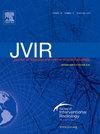Resin-Based Yttrium-90 Radioembolization as a Bridging or Downstaging Treatment to Liver Transplantation for Hepatocellular Carcinoma
IF 2.6
3区 医学
Q2 PERIPHERAL VASCULAR DISEASE
Journal of Vascular and Interventional Radiology
Pub Date : 2025-02-01
DOI:10.1016/j.jvir.2024.10.021
引用次数: 0
Abstract
Purpose
To evaluate the outcomes of resin-based yttrium-90 (90Y) transarterial radioembolization (TARE) for hepatocellular carcinoma (HCC) as a bridging or downstaging therapy to liver transplantation (LT) in terms of safety, tumor response, recurrence, and survival.
Materials and Methods
A single-center retrospective analysis of patients with HCC treated with resin-based TARE as bridging or downstaging treatment to LT between January 2006 and April 2021 was performed. TARE-related liver toxicity was assessed. Imaging data were analyzed to assess tumor response. Histopathological analysis of explant livers was performed to assess HCC necrosis. Survival and bridging/downstaging success predictor analysis was performed.
Results
Thirty-six patients underwent resin-based TARE with the intention to bridge (33%) or downstage (67%) to LT. Overall, 44% had ≥3 HCC lesions, and 53% had bilobar disease. Median largest tumor diameter was 3.4 cm. TARE was segmental, lobar, and bilobar in 20%, 36%, and 44% of cases, respectively. In total, 17% had Grade 3 bilirubin toxicities. The objective response rate per modified Response Evaluation Criteria in Solid Tumours was 72%. Patients meeting the United Network for Organ Sharing Downstaging criteria had higher chances of successful bridging/downstaging. Twenty-three patients were transplanted. Complete pathological response was noted in 30% of explant livers. Posttransplant tumor recurrence occurred in 26% within a median follow-up period of 1,710 days. Estimated 5-year progression-free, disease-specific, and overall survival rates after LT were 89%, 69%, and 89%, respectively. For the entire patient cohort, these survival rates were 87%, 53%, and 70%, respectively.
Conclusions
Resin-based 90Y TARE can be considered a valuable treatment option for bridging or downstaging patients with HCC to LT, including patients requiring lobar or bilobar TARE for extensive tumoral disease.

以树脂为基础的钇-90放射栓塞作为肝细胞癌肝移植的过渡或降期治疗方法
目的:从安全性、肿瘤反应、复发和存活率等方面评估肝细胞癌(HCC)树脂基钇-90放射栓塞术(TARE)作为肝移植(LT)过渡或降期治疗的效果:对2006年1月至2021年4月期间接受树脂基TARE作为肝移植桥接或降期治疗的HCC患者进行了单中心回顾性分析。评估了与TARE相关的肝脏毒性。分析成像数据以评估肿瘤反应。对取出的肝脏进行组织病理学分析,以评估 HCC 坏死情况。进行了存活率和桥接/降期成功预测分析:36名患者接受了树脂TARE,目的是桥接(33%)或降期(67%)至LT。44%的患者有≥3个HCC病灶,53%的患者有双叶病变。最大肿瘤直径中位数为3.4厘米。20%、36%和44%的病例的TARE分别为节段性、分叶性和双叶性。17%的患者出现3级胆红素毒性反应。mRECIST客观反应率为72%。符合UNOS-DS标准的患者成功桥接/降期的几率更高。23 名患者接受了移植。30%的移植肝出现完全病理反应。移植后肿瘤复发的比例为 26%,中位随访时间为 1710 天。估计LT术后5年无进展生存率、疾病特异性生存率和总生存率分别为89%、69%和89%。在整个患者队列中,这些比率分别为87%、53%和70%:树脂90Y TARE可被视为HCC患者向LT过渡或降期的重要治疗选择,包括因广泛肿瘤疾病而需要(双)肺叶TARE的患者。
本文章由计算机程序翻译,如有差异,请以英文原文为准。
求助全文
约1分钟内获得全文
求助全文
来源期刊
CiteScore
4.30
自引率
10.30%
发文量
942
审稿时长
90 days
期刊介绍:
JVIR, published continuously since 1990, is an international, monthly peer-reviewed interventional radiology journal. As the official journal of the Society of Interventional Radiology, JVIR is the peer-reviewed journal of choice for interventional radiologists, radiologists, cardiologists, vascular surgeons, neurosurgeons, and other clinicians who seek current and reliable information on every aspect of vascular and interventional radiology. Each issue of JVIR covers critical and cutting-edge medical minimally invasive, clinical, basic research, radiological, pathological, and socioeconomic issues of importance to the field.

 求助内容:
求助内容: 应助结果提醒方式:
应助结果提醒方式:


